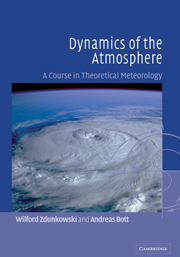Book contents
- Frontmatter
- Contents
- Preface
- Part 1 Mathematical tools
- Part 2 Dynamics of the atmosphere
- 1 The laws of atmospheric motion
- 2 Scale analysis
- 3 The material and the local description of flow
- 4 Atmospheric flow fields
- 5 The Navier–Stokes stress tensor
- 6 The Helmholtz theorem
- 7 Kinematics of two-dimensional flow
- 8 Natural coordinates
- 9 Boundary surfaces and boundary conditions
- 10 Circulation and vorticity theorems
- 11 Turbulent systems
- 12 An excursion into spectral turbulence theory
- 13 The atmospheric boundary layer
- 14 Wave motion in the atmosphere
- 15 The barotropic model
- 16 Rossby waves
- 17 Inertial and dynamic stability
- 18 The equation of motion in general coordinate systems
- 19 The geographical coordinate system
- 20 The stereographic coordinate system
- 21 Orography-following coordinate systems
- 22 The stereographic system with a generalized vertical coordinate
- 23 A quasi-geostrophic baroclinic model
- 24 A two-level prognostic model, baroclinic instability
- 25 An excursion concerning numerical procedures
- 26 Modeling of atmospheric flow by spectral techniques
- 27 Predictability
- Answers to Problems
- List of frequently used symbols
- References and bibliography
- Index
12 - An excursion into spectral turbulence theory
Published online by Cambridge University Press: 05 June 2012
- Frontmatter
- Contents
- Preface
- Part 1 Mathematical tools
- Part 2 Dynamics of the atmosphere
- 1 The laws of atmospheric motion
- 2 Scale analysis
- 3 The material and the local description of flow
- 4 Atmospheric flow fields
- 5 The Navier–Stokes stress tensor
- 6 The Helmholtz theorem
- 7 Kinematics of two-dimensional flow
- 8 Natural coordinates
- 9 Boundary surfaces and boundary conditions
- 10 Circulation and vorticity theorems
- 11 Turbulent systems
- 12 An excursion into spectral turbulence theory
- 13 The atmospheric boundary layer
- 14 Wave motion in the atmosphere
- 15 The barotropic model
- 16 Rossby waves
- 17 Inertial and dynamic stability
- 18 The equation of motion in general coordinate systems
- 19 The geographical coordinate system
- 20 The stereographic coordinate system
- 21 Orography-following coordinate systems
- 22 The stereographic system with a generalized vertical coordinate
- 23 A quasi-geostrophic baroclinic model
- 24 A two-level prognostic model, baroclinic instability
- 25 An excursion concerning numerical procedures
- 26 Modeling of atmospheric flow by spectral techniques
- 27 Predictability
- Answers to Problems
- List of frequently used symbols
- References and bibliography
- Index
Summary
The phenomenological theory discussed in the previous chapter did not permit the parameterization of the energy dissipation. In this chapter spectral turbulence theory will be presented to the extent that we appreciate the connections among the turbulent exchange coefficient, the energy dissipation, and the turbulent kinetic energy. In the spectral representation we think of the longer waves as the averaged quantities and the short waves as the turbulent fluctuations. Since the system of atmospheric prediction equations is very complicated we will be compelled to apply some simplifications.
Fourier representation of the continuity equation and the equation of motion
Before we begin with the actual transformation it may be useful to briefly review some basic concepts. For this reason let us consider the function a(x) which has been defined on the interval L only. In order to represent the function by a Fourier series, we extend it by assuming spatial periodicity. Using Cartesian coordinates we obtain a plot as exemplified in Figure 12.1. The period L is taken to be large enough that averaged quantities within L may vary, i.e. the averaging interval Δx ≪≪ L.
Certain conditions must be imposed on a(x) in order to make the expansion valid. The function a(x) must be a bounded periodic function that in any one period has at most a finite number of local maxima and minima and a finite number of points of discontinuity.
- Type
- Chapter
- Information
- Dynamics of the AtmosphereA Course in Theoretical Meteorology, pp. 326 - 348Publisher: Cambridge University PressPrint publication year: 2003



